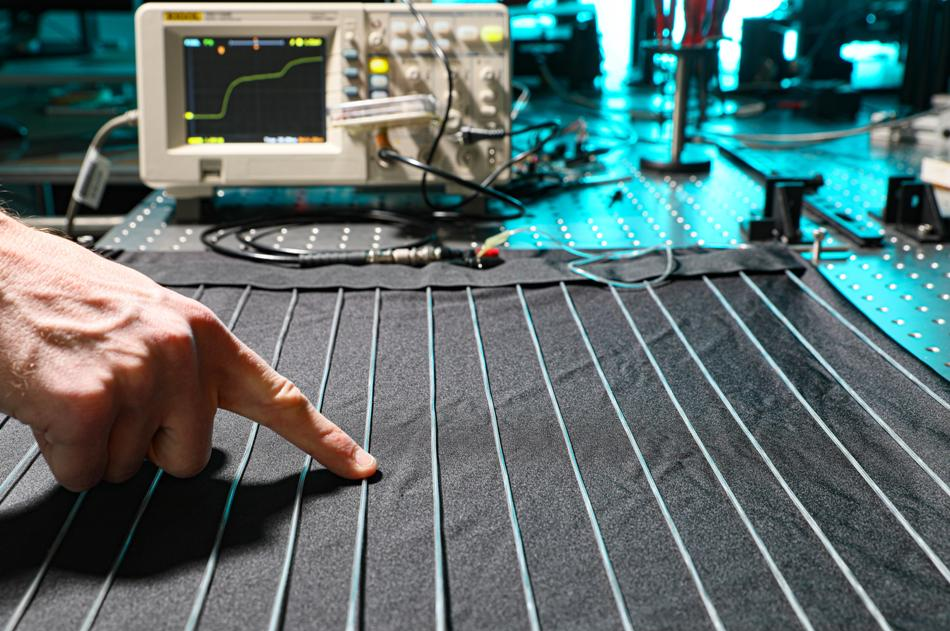Jun 2 2020
Scientists at École polytechnique fédérale de Lausanne (EPFL) have designed electronic fibers that, while embedded in textiles, can gather a great deal of information about the body of humans by quantifying complex and subtle deformations of fabrics.
 EPFL researchers have developed electronic fibers that, when embedded in textiles, can be used to collect data about our bodies by measuring fabric deformation. Their technology employs flexible transmission lines and offers a host of applications, including in the medical industry. Image Credit: EPFL.
EPFL researchers have developed electronic fibers that, when embedded in textiles, can be used to collect data about our bodies by measuring fabric deformation. Their technology employs flexible transmission lines and offers a host of applications, including in the medical industry. Image Credit: EPFL.
The new technology is based on transmission line theory and provides a host of applications, for example, in robotics and health care.
At the Laboratory of Photonic Materials and Fibre Devices (FIMAP) in EPFL’s School of Engineering, Professor Fabien Sorin and doctoral assistant Andreas Leber have designed a technology that can be employed to detect the movements of a human body.
Imagine clothing or hospital bed sheets capable of monitoring your breathing and other vital movements, or AI-powered textiles that allow robots to interact more safely and intuitively with humans. The soft transmission lines that we’ve developed open the door to all of this.
Andreas Leber, Doctoral Assistant, Laboratory of Photonic Materials and Fibre Devices, School of Engineering, EPFL
Stretching, Pressing, and Twisting
The team has developed a sensor with the ability to simultaneously detect various kinds of fabric deformation such as torque, pressure, and stretch.
Finding a method for differentiating all these convoluted movements was our biggest challenge, because it is very difficult for sensors to measure several stimulations simultaneously.
Andreas Leber, Doctoral Assistant, Laboratory of Photonic Materials and Fibre Devices, School of Engineering, EPFL
Leber continued, “Also, conventional sensors in textiles have several drawbacks. First, they are fragile and break easily. Second, you need a lot of them to cover a large area, which eliminates many of the advantages of fabrics. And third, each type of conventional sensor can detect only one kind of deformation.”
However, by taking the ideas from reflectometry, Sorin and Leber could develop soft fiber-shaped sensors that pave a new way for smart textiles.
Our technology works similar to a radar, but it sends out electrical pulses instead of electromagnetic waves. That means our fiber sensors operate like transmission lines, known from high-frequency communication. The system measures the time between when a signal is sent out and when it’s received, and uses that to determine the exact location, type and intensity of deformation.
Andreas Leber, Doctoral Assistant, Laboratory of Photonic Materials and Fibre Devices, School of Engineering, EPFL
Detection technology of this type has never been used in structures that combine high electronic performance with higher mechanical flexibility, both of which are essential for quantifying deformations.
Liquid Metal and Fiber Optics Processing
Making the fibers is a complicated task that involves an optical fiber fabrication process used on uncommon materials such as elastomers or liquid metals that act as the conductors.
According to Leber, “The structure includes micrometer-size features and has to be perfect, otherwise it won’t work.”
With such fibers, the total surface of the fabric acts as one large sensor. “The trick was to create transmission lines made entirely of soft materials, using a simple method that can be scaled up,” stated Sorin.
The study drew on a range of disciplines such as materials science, mechanical engineering, and electrical engineering. A further step in this study will be to make the technology more portable by decreasing the footprint of peripheral electronics.
This study was funded by the European Research Council (ERC Starting Grant 679211 “FLOWTONICS”).
Journal Reference:
Leber, A., et al. (2020) Soft and stretchable liquid metal transmission lines as distributed probes of multimodal deformations. Nature Electronics. doi.org/10.1038/s41928-020-0415-y.